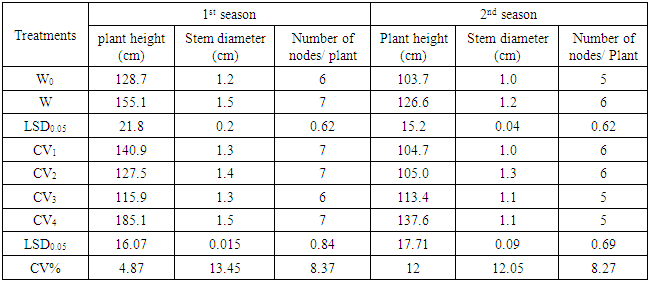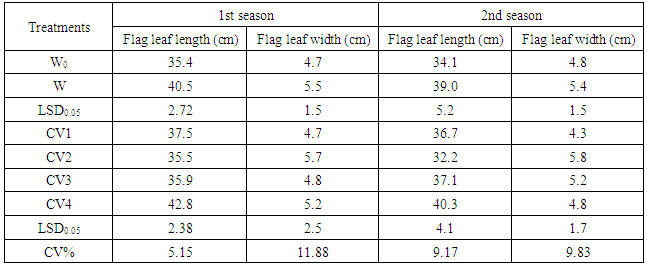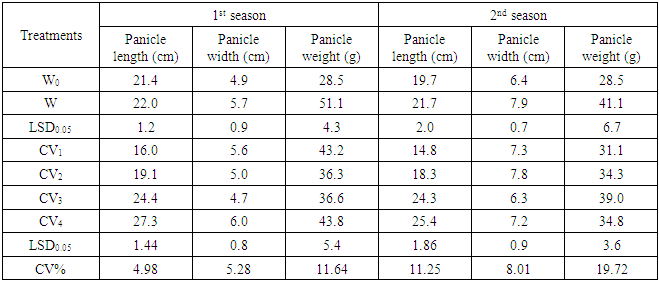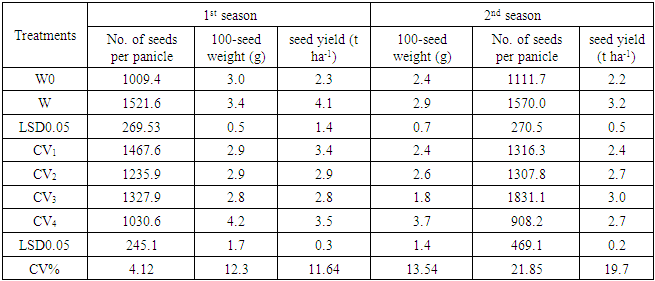-
Paper Information
- Next Paper
- Previous Paper
- Paper Submission
-
Journal Information
- About This Journal
- Editorial Board
- Current Issue
- Archive
- Author Guidelines
- Contact Us
International Journal of Agriculture and Forestry
p-ISSN: 2165-882X e-ISSN: 2165-8846
2018; 8(2): 77-82
doi:10.5923/j.ijaf.20180802.05

Performance of In-situ Rain Water Harvesting on Yield of Grain Sorghum in Gradud Soil of North Kordofan
Ahmed M. El Naim1, Sabah M. Hamoda1, Elshiekh A. Ibrahim1, Moayad M. B. Zaied1, Elsadig B. Ibrahim2
1Department of Crop Sciences, Faculty of Natural Resources and Environmental Studies, University of Kordofan, Elobied, Sudan
2Department of Crop Sciences, Faculty of Natural Resources and Environmental Studies, Peace University, El Fulla, Sudan
Correspondence to: Ahmed M. El Naim, Department of Crop Sciences, Faculty of Natural Resources and Environmental Studies, University of Kordofan, Elobied, Sudan.
| Email: |  |
This work is licensed under the Creative Commons Attribution International License (CC BY).
http://creativecommons.org/licenses/by/4.0/

Shortage of rainfall is one of the most severe stresses faced the crop productivity in the Sudan. The continued decrease in productivity of the crops in North Kordofan resulting from rainfall decline and drought. These necessitate application of micro-catchment water harvest methods and techniques to catch small amount of rainfall available, in order to increase crop productivity. Afield experiment was conducted during two consecutive seasons, under rain fed condition in gradud soil of North Kordofan State. The aim of this study was to investigate the effect of in-situ water harvesting technique on growth and yield of four sorghum (Sorghum bicolor L. moench) cultivars. The Strip Plot Design with four replications was used. The results showed that in-situ water harvesting treatment had significant effect on the most parameters measured. It has increased the number of seeds per panicle, 100- seed weight, panicle weight and preform a highest seed yield (t ha-1). In addition, the results revealed that the improved cultivar (Yourwasha) performed the best for most of the characters measured. It revealed a highest 100- seeds weight, seeds yield per plant and the final seed yield (approximately 3.5 t ha-1).
Keywords: Micro-catchment, Rainfall, Climate change, Sorghum bicolor
Cite this paper: Ahmed M. El Naim, Sabah M. Hamoda, Elshiekh A. Ibrahim, Moayad M. B. Zaied, Elsadig B. Ibrahim, Performance of In-situ Rain Water Harvesting on Yield of Grain Sorghum in Gradud Soil of North Kordofan, International Journal of Agriculture and Forestry, Vol. 8 No. 2, 2018, pp. 77-82. doi: 10.5923/j.ijaf.20180802.05.
Article Outline
1. Introduction
- Sorghum (Sorghum bicolor L. moench) is one of the crops that tolerate drought in stressed environments [1], and is an excellent model for drought tolerance in higher plants [2, 3]. This cereal has unusual and superior tolerance to excessive heat conditions [4], and produces reasonable grain yield in poor soils [5]. It can also withstand long exposure to water logged soil conditions [6]. Sorghum originated from Eastern Africa [7] and was probably first domesticated in horn of Africa between 5000 and 7000 years ago [8]. The greatest diversity of sorghum in both cultivated and wild species is found in the North Eastern quadrant of the cereal [9]. Sorghum is recognized as the fifth most important crops in the world. In Africa, it is ranked second in terms of production [10] and in Sudan is listed as an important staple traditional food crop. World sorghum production expanded from 40 million tons at the beginning of the 1960s to 66 million tons in 1979-81. However, by 1990 it had fallen to 58 million tons, though the area under sorghum declined only slightly, from 45.6 million to 44.4 million hectares, during the same period. The reduction in production from 1979-81 to 1990 was largely due to a decline in two major sorghum-producing countries, the United States and China. These two countries accounted for 6.2 million tons or 85 percent of the reduction in the global production figures. There are several reasons for the declining trend in the production of sorghum, including unpredictable and erratic distribution of rainfall (most of the sorghum grown is rain-fed), declining soil fertility, the inefficient production systems employed in individual countries, biotic and a biotic stresses and declining demand for sorghum. The growth in food demand (2.9 percent) for the period 1980 to 2000 in 90 developing countries will marginally exceed projected agricultural production growth (2.8 percent). However, the imbalance will be more pronounced in Africa (demand 3.4 percent, production growth 2.6 percent). In the least-developed countries, production growth is predicted to lag 25 percent below the growth of demand. In arid, less developed regions of the world, sorghum is an important food crop especially for subsistence farmers. Millions of people in semi-arid regions of Africa and Asia use sorghum as the most important staple food, serving as the main source of energy, and protein, minerals and vitamins [11]. Sorghum is considered to be a “power house of nutrition” and is a rich source of protein, niacin, iron and vitamin B1 and a good source of vitamin B2. Some varieties are rich in antioxidants and all varieties are gluten-free, offering an alternative for those who suffer from wheat allergies. Sorghum is used to produce such foods as porridges, breads, couscous, sorghum flour syrup, malted flours for brewing, In Sudan the flour from the grain can be used to make kisra, porridge, gruel, local beer and snack meals like Balleela [12]. Climate change has resulted in increased vulnerability of smallholder farmers in marginal areas of Kordofan where there is limited capacity to adapt or transform to climate-smart agriculture. One approach that has been used to adapt to changing climate or developing climate smart agriculture is rainwater harvesting for improved crop yields in the North Kordofan. Micro catchments are simple to construct and can be built rapidly using local materials. Once constructed, minimal maintenance is required. The rainfall runoff collected by micro catchments has low salt content and within catchments leaching is enhanced and soil salinity is often reduced [13]. Micro catchments have been used successfully with domesticated crops for centuries, but have only recently been used to supplement rainfall for native vegetation [14]. The objective of the present work is to study the effect of in situ rainwater harvesting and cultivars on growth and yield of sorghum in North Kordofan.
2. Materials and Methods
2.1. Experiment
- A field experiment was conducted during two consecutive seasons under rain fed conditions at Kordofan mountain Research Farm in North Kordofan State. To investigate the effects of in-situ rain water harvesting and cultivar on growth and yield of grain sorghum (sorghum bicolor (L) moench). The climate of the area is arid and semiarid. The soil is clay (gardud) with low fertility. Rainfall ranged between 200 and 500 mm. Average maximum daily temperature varied between 30°C-35°C most of the year [15, 16].The experiment laid out in a Strip Plot Design with four replications. The experimental unit was 9×4 meters. The water harvesting treatments consisted of In-situ rainwater harvesting (micro catchment) by using terraces and non-water harvesting designated, as W and W0, respectively. The micro-catchment rainwater technique made manual by labor using terraces ties. Four improved cultivars of the grain sorghum, Dwarf Milo, Arfagadamec 8, Butana and Yourwasha were used, henceforth designated as CV1, CV2, CV3, and CV4 respectively. The seeds were obtained from Arab Sudanese Seed Company, Elobeid.Sowing was on 14th of July for the first season and second season. Seeds were sown on furrow at a spacing of 50cm between furrow and within furrow. Six seeds were placed in each hole, which were then thinned to two plants per hole, after two weeks from sowing. The plots weeded twice; the first one was after two weeks from sowing and the second weeding after a month from the first weeding.
2.2. Growth Attributes
- Five plants were selected at random from the middle row to measure the following parameters:1- Plant height (cm): measured from soil surface to the tip of the main panicle, at the physiological maturity. 2- Stem diameter (cm): measured by using a vernier (caliper) at the third node.3- Number of nodes/plant: was determined by counting the number of nodes of the main stem.5- Length of flag leaf (cm).6- Width of flag leaf (cm): was measured at maximum width.
2.3. Yield Attributes
- 1- Panicle length (cm): Mean length of the panicle measured on a sample of four panicles measured from the base to the tip of the head.2- Panicle width (cm): Mean width of the panicle measured on a sample of four panicles measured at the maximum width of the panicle. 3- Number of seeds per panicle: 4- 100- seed weight (g): 100 seeds will be weighted (four times) from each sample and weighed.5- Grain yield per plant (g) 6- Grain yield (kg/ha): Calculated by using the following formula:

2.4. Statistical Analysis
- The collected data were analyzed for the estimation of the statistical parameters using IRRSTAT software package. For comparison of means, least significant Differences (L.S.D) was used at 0.05 level of significance, according to the procedure described by Gomez and Gomez [17].
3. Result and Discussion
3.1. Vegetative Growth Attributes
- Table 1 shows the effect of in-situ water harvesting and cultivar on plant height (cm), stem diameter (cm) and number of nodes per plant. The micro-catchment water harvesting treatments had significant effect on growth attributes such as plant height, stem diameter, number of nodes per plant, flag leaf length and width (Table 2). These parameters increased in water harvesting treatments. This indicates that vegetative growth is directly proportional to the available soil water content and consumptive water use. In situ water harvesting techniques encouraged the soil to absorb and store more water within the root zone throughout the growing season.Water harvesting technique was superior in stem diameter. The results showed that the water harvesting increased the plant height during the both seasons, because it led to increase the rate of leakage of water into the soil and which led to increased soil moisture content. Elramlawi et al. [18] reported that in-situ water harvesting techniques increased the yields of maize and accompanied with increase of plant population (plants/m2), stem diameter, plant height and dry matter weight.El Naim [19] confirmed that leaf area was reduced by water shortage, which was attributed to the effect on cell division, lamina expansion (cell number and cell enlargement) and leaf production. Number of leaves per plant produced by a plant is directly proportional to the photosynthetic produced. Micro catchment resulted in positive results in the number of nodes per plant in the two season, has been found that there is a direct relationship between the number of nodes and productivity. Water harvesting (Increased soil moisture) increased shoot dry weight per plant. The similar result was obtained by El Naim [20] in sunflower and Balasabramaniyan and Dharmalingam [21] in sesame by increasing water quantities. This is because of better plant height, stem diameter, branches and better total leaf area per plant. Ohiri and Ezumah [22] found that conservation tillage operations loosen, granulate, crush or compact soil structure, changing soil properties such as bulk density, pore size distribution and composition of the soil atmosphere that affect plant growth. Mohammed et al. [12] found that micro-catchment treatment was highest in stem diameter, number of nodes per plant and plant density. He also found that tillage depth of 15cm was effective and recommended to improved vegetative growth and productivity of grain sorghum. Aikins and Afuakwa [23], Jabereldar [34] and Ahmed [35], they found that moisture stress treatment produced the shortest plant, smallest stem girth and smallest number of leaves.Sorghum cultivars had significant effect on plant height (Table 1). This result confirmed the results of previous studies of Abdulla [24], Hassan [25], Alejandro [26], Abdu Rahman [27], Bakheit [28], and El Naim et al [16]. They found that the cultivars of grain sorghum significantly affect the plant height. Cultivars had significant effect on Flag leaf width (Table 2). Milo characterized by a narrow leaf surface area (4.7 cm) among the other three studied cultivars, the matter considered an advantage; especially during unfavorable environmental condition as pointed out by Dennis et al. [29] “In sorghum reduction in leaf surface area through rolling is important for transpiration control under drought stress”.
|
|
3.2. Yield Attributes
- Table 3 represents the effect of the in-situ water harvesting and cultivars on panicle weight (g), panicle length and width. The in-situ water harvesting treatments had significant effect on panicle weight, panicle length and width.Karrar et al. [30] reported that the chisel and contour bundling every 10 meters were better than the flat technique in improving soil physical properties.As well as increasing soil water storage and grain yield by 152% over the control.Farah et al. [31] found that in the studies carried out at Gedarif the grain yield increased by earth bund techniques compared to the control. However, planting between the ridges resulted in a 13% decrease in yield compared with control. Elamin [32] reported that in-situ water harvesting techniques significantly increased storage capacity of the soil for water and significantly increased the grain yield by 43%, 33% and 32% for semicircular, terrace and L shaped techniques, respectively, compared to the flat (control). The results of Wenzel [33] indicated that moisture stress directly or indirectly affected all characteristics (grain yield, tillering, seeds per ear, ear mass, seeds per plot, thousand seed mass, Stover mass, biomass) evaluated.Micro-catchment water harvesting had a highest numbers of seeds per panicle in two seasons (Table 4). Non-water harvesting treatment (W0) had a lesser number of seeds per panicle. The results indicated that 100 seed weight had no significant different among treatments in both seasons. Generally the water harvesting improved seed weight per panicle in the two seasons (Table 4), however the water harvesting treatment had a highest seeds weight per panicle. This is because it had a highest number of seeds per panicle compared to others. The superiority of water harvesting in producing the largest number of panicles per plot, greatest number of seeds per panicle and highest grain yield was associated with increased soil loosening. These results agree with that of [23] who reported that micro catchment plots gave higher number of seeds than that of not harvesting water plots. Karrar et al, [30] found that in-situ water harvesting techniques was effective and recommended to improved vegetative growth and productivity of grain sorghum. Water harvesting was highest in number of panicles/m2, number of grains per panicle and final grain yield (t ha-1). Jabereldar et al. [34] noticed that the water stress at eight-leaf stage reduced panicle length, panicle weight, number of grains per panicle, 100- grain weight, seed yield in sorghum.
|
|
4. Conclusions
- From this study, it could be concluded that; the In-situ water harvesting technique increased seed yield (productivity) of sorghum in gardud soil of North Kordofan state and recommended to be applied and practice by farmers especially in areas facing shortage in rainfall. Further studies could be carried out in order to reinforce (buttress) the result obtained in this experiment. Researchers in further studies should try the effect of micro catchment water harvesting methods (furrow ridge, contour bench square or crescent terraces etc.) through replicated field experiments to identify proper technique under North Kordofan environment.
ACKNOWLEDGMENTS
- The authors would like to express their sincere appreciation and thanks for Ministry of Higher Education and Scientific Research (Sudan) for financial support of this research project (62-2016).
 Abstract
Abstract Reference
Reference Full-Text PDF
Full-Text PDF Full-text HTML
Full-text HTML


